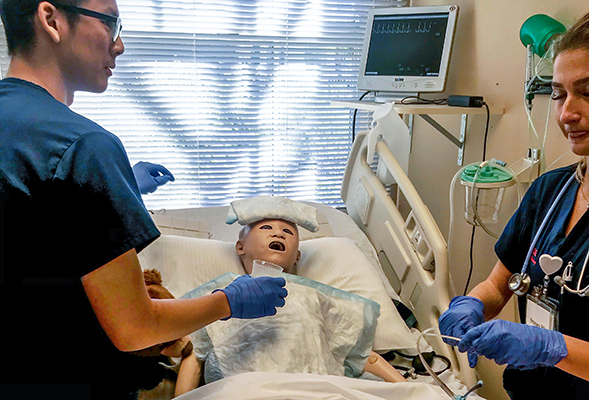School of Nursing Commits to Advancing Patient Safety
SDSU is among the first four institutions to adopt a newly established patient safety curriculum, aimed at reducing preventable deaths in hospitals.

“We want to be able to take the pieces of this curriculum and embed it in what we do.”
A distracted pharmacy technician puts the wrong medication into a pill packet. A nurse misreads 30 cc as 300 and delivers an overdose of normally harmless potassium for the heart. A feeding tube inserted through the nose takes a wrong turn and winds up in the patient’s lung instead of the stomach.
Medical errors can cause death or serious injury, and just one incident can cost a hospital hundreds of thousands of dollars that insurers won’t cover.
Now, San Diego State University’s School of Nursing has joined the forefront of a movement to eliminate preventable errors, as part of the basic education of health care professionals.
The school is one of the first four organizations in the world to commit to an established patient-safety curriculum that begins in the freshman year and continues through graduate studies. The goal is to have students well-versed in the concepts long before they set foot in a hospital.
Developed by an Irvine-based non-profit organization called the Patient Safety Movement Foundation (PSMF), the curriculum reinforces behaviors and tools—many of which already are part of nursing education—specifically aimed at eliminating preventable medical error.
“Patient safety is a critical concern,” said School of Nursing Director Philip Greiner, who served on the committee that developed the curriculum. “Patients should not die because of things we do.”
The foundation estimates more than 200,000 people die every year in U.S. hospitals from causes that include infections, medication errors, and falls. The curriculum addresses issues that span technology, health care systems, teamwork, communication and more, to advance a culture of safety, which can include matters as simple as picking up a piece of paper from the floor to avert a slip-and-fall hazard.
Continuing program
The School of Nursing enrolls about 500 undergraduate and 75 graduate students. Greiner said the patient safety curriculum isn’t designed to be taught all at once, but will be seen at every level of teaching, particularly the adult geriatric nurse practitioner program.
“As undergraduates, we want everybody to learn these facets,” he said. “We want to be able to take the pieces of this curriculum and embed it in what we do.”
The principles will be incorporated into the school’s existing Quality and Safety Education for Nurses program. Among other uses, Greiner said, the curriculum looks like a good fit with the school’s three-step Professional Formation sequence, which begins in the sophomore year.
“In many ways, nursing is ahead of the game compared to some of the other professions because we have already invested in quality and safety,” Greiner said. “This takes it to another level.”
Now worldwide, PSMF was founded in 2012 by SDSU electrical engineering alumnus Joe Kiani (’85, ’87), who serves on the College of Engineering Dean’s Advisory Board. The foundation works with health care organizations, technology companies, educational institutions and other partners toward a goal of “ZERO preventable deaths.”
In addition to SDSU, other schools that committed to the patient safety curriculum were Chapman University School of Pharmacy in Irvine, Geisinger Commonwealth School of Medicine in Pennsylvania, and Universidad Autónoma de México School of Medicine.



